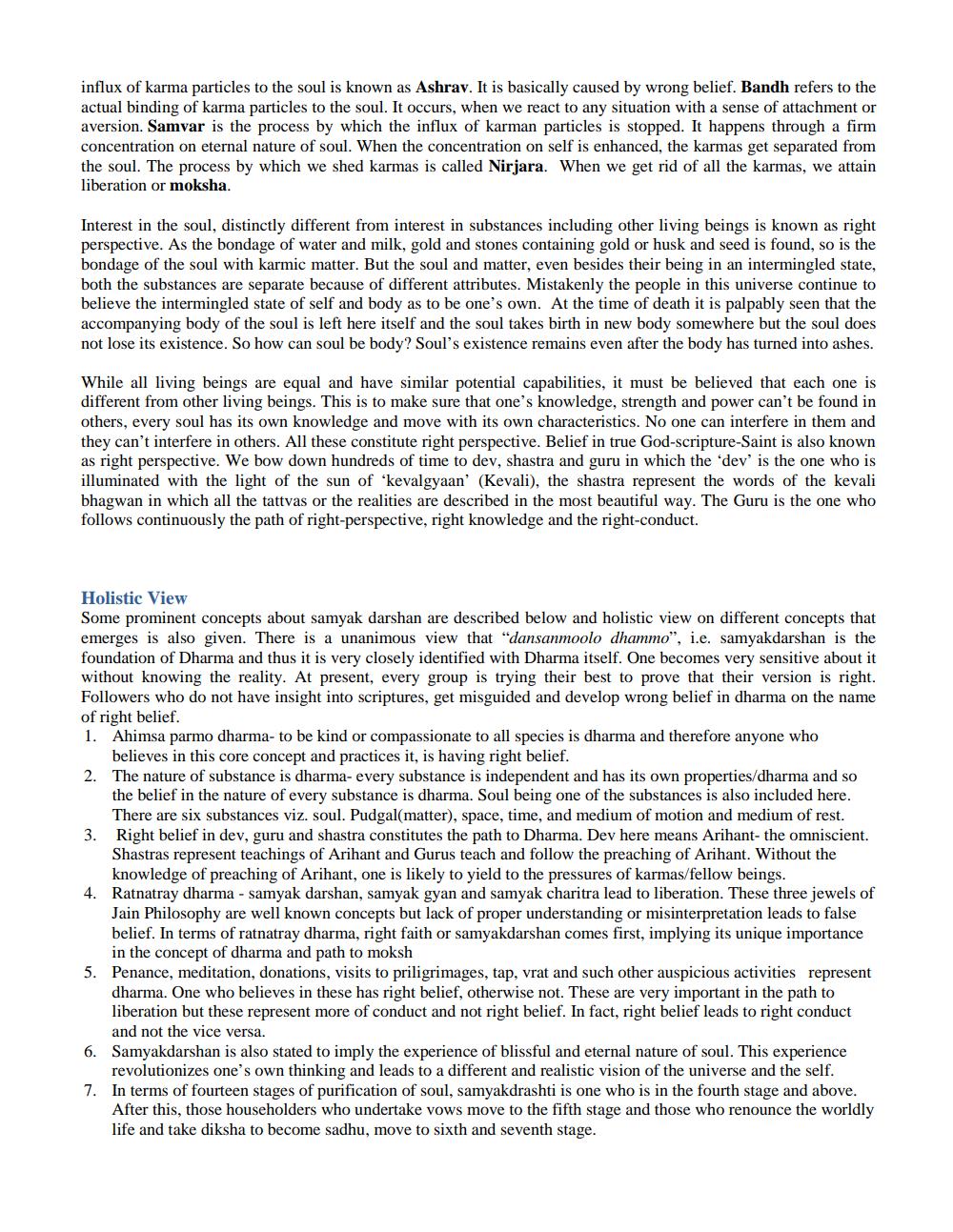________________
influx of karma particles to the soul is known as Ashrav. It is basically caused by wrong belief. Bandh refers to the actual binding of karma particles to the soul. It occurs, when we react to any situation with a sense of attachment or aversion. Samvar is the process by which the influx of karman particles is stopped. It happens through a firm concentration on eternal nature of soul. When the concentration on self is enhanced, the karmas get separated from the soul. The process by which we shed karmas is called Nirjara. When we get rid of all the karmas, we attain liberation or moksha.
Interest in the soul, distinctly different from interest in substances including other living beings is known as right perspective. As the bondage of water and milk, gold and stones containing gold or husk and seed is found, so is the bondage of the soul with karmic matter. But the soul and matter, even besides their being in an intermingled state, both the substances are separate because of different attributes. Mistakenly the people in this universe continue to believe the intermingled state of self and body as to be one's own. At the time of death it is palpably seen that the accompanying body of the soul is left here itself and the soul takes birth in new body somewhere but the soul does not lose its existence. So how can soul be body? Soul's existence remains even after the body has turned into ashes.
While all living beings are equal and have similar potential capabilities, it must be believed that each one is different from other living beings. This is to make sure that one's knowledge, strength and power can't be found in others, every soul has its own knowledge and move with its own characteristics. No one can interfere in them and they can't interfere in others. All these constitute right perspective. Belief in true God-scripture-Saint is also known as right perspective. We bow down hundreds of time to dev, shastra and guru in which the 'dev' is the one who is illuminated with the light of the sun of 'kevalgyaan' (Kevali), the shastra represent the words of the kevali bhagwan in which all the tattvas or the realities are described in the most beautiful way. The Guru is the one who follows continuously the path of right-perspective, right knowledge and the right-conduct.
Holistic View
Some prominent concepts about samyak darshan are described below and holistic view on different concepts that emerges is also given. There is a unanimous view that "dansanmoolo dhammo", i.e. samyakdarshan is the foundation of Dharma and thus it is very closely identified with Dharma itself. One becomes very sensitive about it without knowing the reality. At present, every group is trying their best to prove that their version is right. Followers who do not have insight into scriptures, get misguided and develop wrong belief in dharma on the name of right belief.
1. Ahimsa parmo dharma- to be kind or compassionate to all species is dharma and therefore anyone who believes in this core concept and practices it, is having right belief.
2. The nature of substance is dharma- every substance is independent and has its own properties/dharma and so the belief in the nature of every substance is dharma. Soul being one of the substances is also included here. There are six substances viz. soul. Pudgal(matter), space, time, and medium of motion and medium of rest.
3. Right belief in dev, guru and shastra constitutes the path to Dharma. Dev here means Arihant- the omniscient. Shastras represent teachings of Arihant and Gurus teach and follow the preaching of Arihant. Without the knowledge of preaching of Arihant, one is likely to yield to the pressures of karmas/fellow beings.
4. Ratnatray dharma - samyak darshan, samyak gyan and samyak charitra lead to liberation. These three jewels of Jain Philosophy are well known concepts but lack of proper understanding or misinterpretation leads to false belief. In terms of ratnatray dharma, right faith or samyakdarshan comes first, implying its unique importance in the concept of dharma and path to moksh
5. Penance, meditation, donations, visits to priligrimages, tap, vrat and such other auspicious activities represent dharma. One who believes in these has right belief, otherwise not. These are very important in the path to liberation but these represent more of conduct and not right belief. In fact, right belief leads to right conduct and not the vice versa.
6. Samyakdarshan is also stated to imply the experience of blissful and eternal nature of soul. This experience revolutionizes one's own thinking and leads to a different and realistic vision of the universe and the self.
7. In terms of fourteen stages of purification of soul, samyakdrashti is one who is in the fourth stage and above. After this, those householders who undertake vows move to the fifth stage and those who renounce the worldly life and take diksha to become sadhu, move to sixth and seventh stage.




